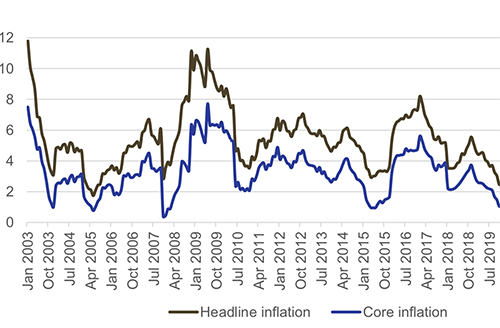Interest rates are expected to remain unchanged at the next scheduled central bank meeting on 25 October 2023, following similar movements by the South African Reserve Bank (SARB) and the Federal Reserve in the United States of America. This is according to local stock brokerage Simonis Storm (SS), who in its latest report noted that September 2023’s inflation rate came in higher as expected at 5.4%.
“Higher inflation rates are in line with our expectations due to increased fuel prices that Namibia is facing”, SS stated. Fuel prices were hiked in September by N$1.20 per litre for petrol and N$1.70 per litre for diesel. In October, hikes were N$1.90 per litre for petrol, and N$2.40 per litre for diesel, respectively.
“Given the cost nature of fuel, especially diesel for various industries, we expect inflation rates to increase in every category. Another addition to inflation is the Rand exchange rate, ranging between R19.21/$ and R18.76/$ during September 2023. The moderation in global food prices has been offset by the weak Rand during September after worries of South Africa’s fiscal deficit, floods, political issues, load shedding and Transnet issues. At the same time, higher oil prices will filter through to higher shipping costs, inflating the import bill and general prices,” the SS report reads.
Meanwhile, the International Monetary Fund (IMF) expects future inflation rate increases to feed into current inflation rates, keeping them elevated. The IMF revised its global inflation forecast upwards from 6.8% to 6.9% in October 2023, with emerging markets expected to see an average of 7.2%.
“The global inflation forecast is lower than 2022’s actual global inflation of 8.7%, underpinned by an expected decline in global energy prices, a slowdown in economic growth worldwide, and continued tightening of monetary policy by central banks. IMF forecasted 4.9% inflation for Namibia, which is lower than our forecast,” SS pointed out.
The latest figures from the central bank indicate that food and non-alcoholic beverages, alcoholic beverages and tobacco, furniture and household maintenance, the culture and hotels and restaurants’ categories were upward drivers of inflation during September.
SS observed that food prices experienced disinflation for the year-to-date (YTD), averaging 10.1% in the third quarter of this year, compared to 12.6% in the previous quarter.
“Namibia is finally experiencing lower increases in food prices, in line with what has been happening on a global sphere. Namibia is a net importer of food products, which exposes the country to various factors which offset lower prices, such as higher import costs or the weakened Rand,” SS stated.
Fresh statistics show fish prices increased 16.9% y/y due to higher global oil prices, and Brent crude, a major input for the sector, surged by 4.4% in August and 9.03% in September 2023. Ropes, nets and other fishing equipment are priced according to global oil prices, increasing the input costs for fish. Coupled with seasonal effects, it pushed food inflation up even further.
Alcohol increased 8.5% y/y and tobacco went up by 5.2% y/y, indicating the perpetual rise in sin taxes.
“Together with higher import costs, the culture and recreation category has the highest inflation rate of 10% because of more expensive holiday packages (up 92.6% y/y) due to increased flight and accommodation costs. Accommodation prices (up 7.6% y/y) and catering services (↑ 6.3% y/y) are high, mainly driven by the peak season of tourism,” SS added.
Furthermore, domestic food inflation has exited the double-digit territory for the first time in nine months. According to SS, food inflation is predicted to become a concern to central bankers after the price of rice surged, and is expected to stay inflated after Thailand rice increased by 50% y/y in September.


